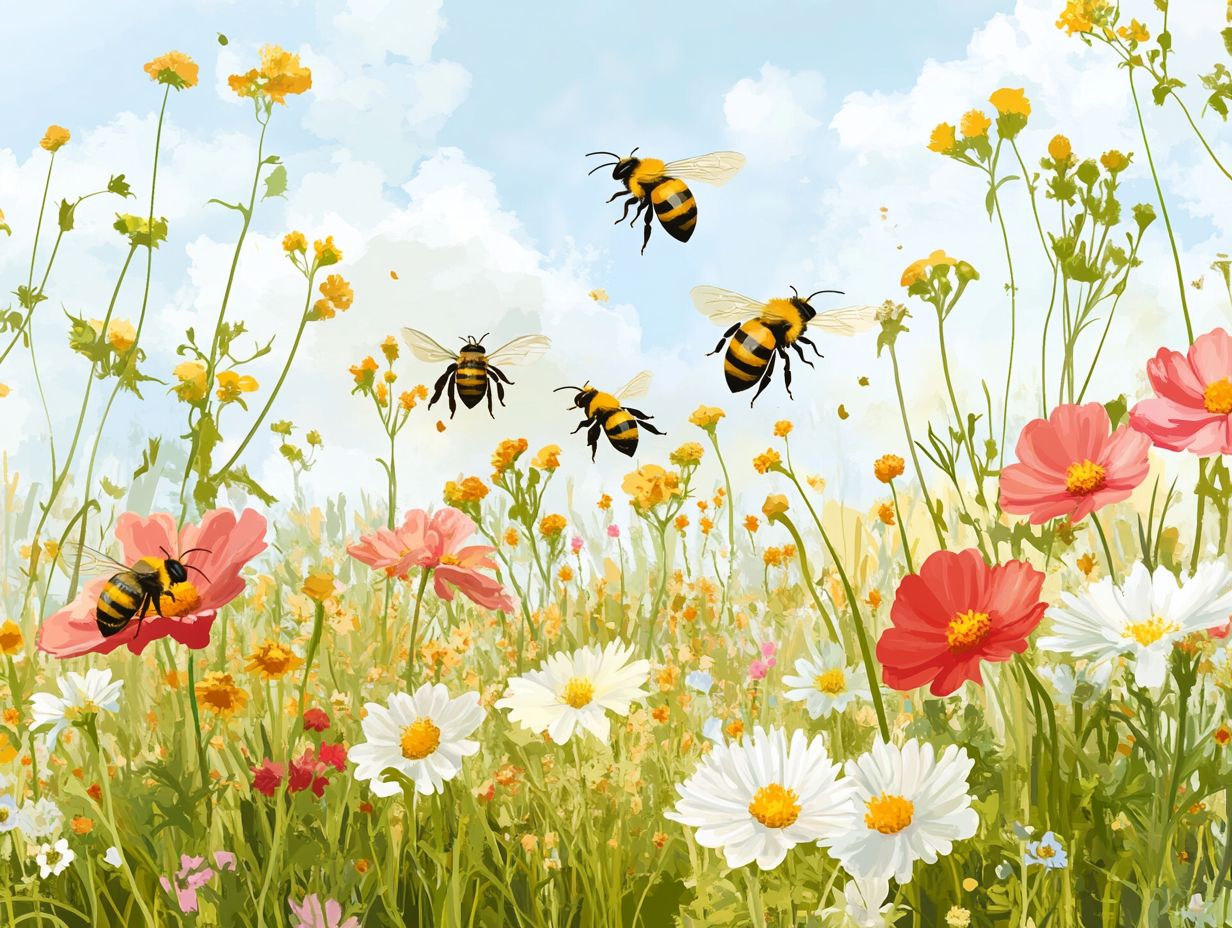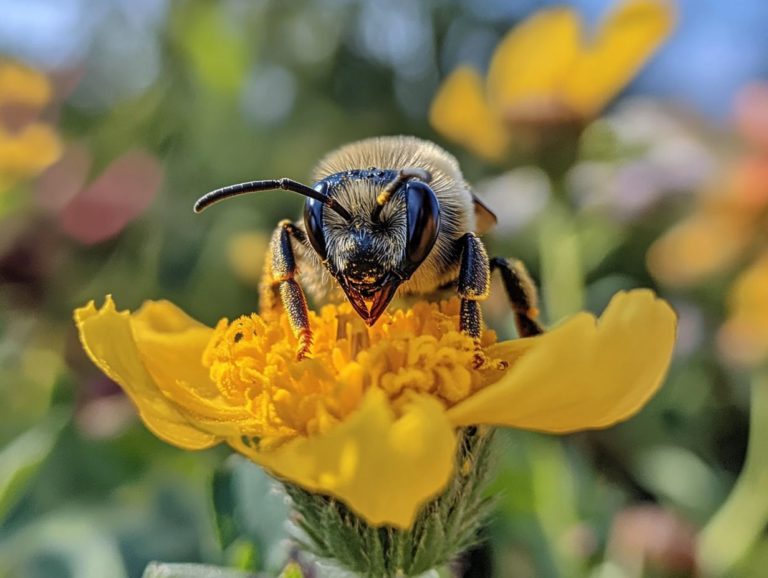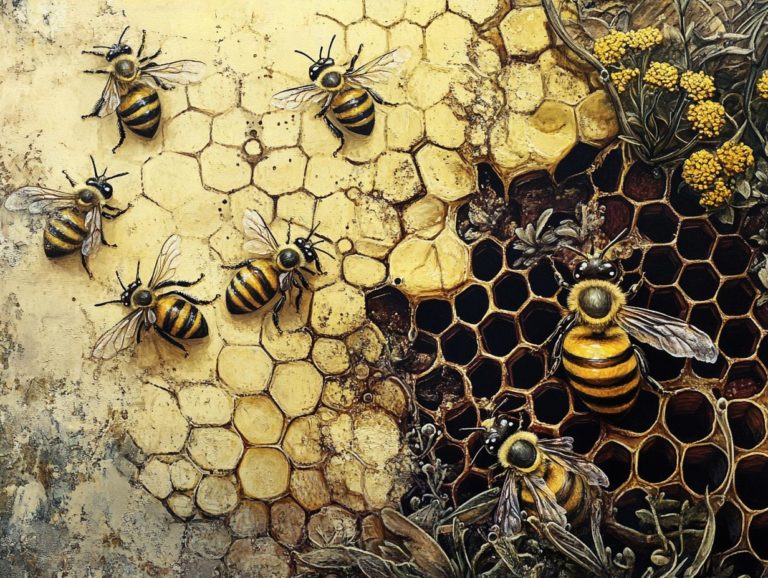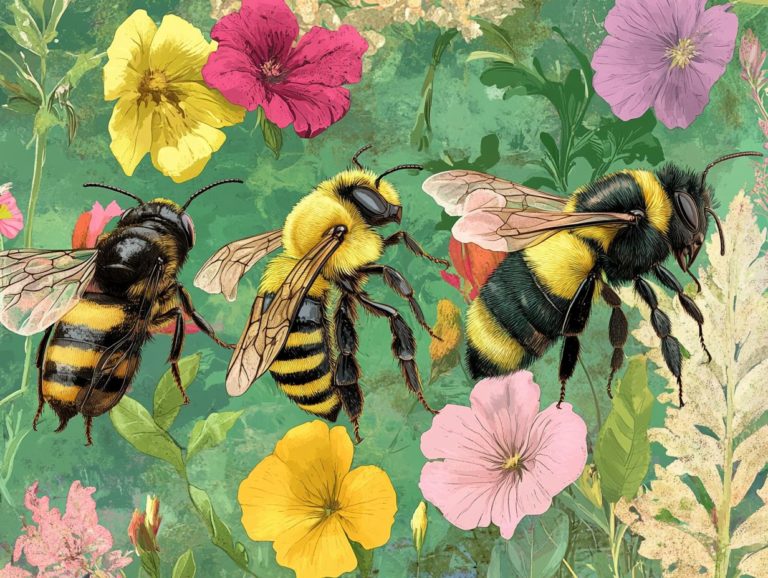Understanding the Importance of Bee Diversity
Bee diversity is a captivating yet frequently overlooked aspect of the natural world. Numerous types of bees play crucial roles in pollination, maintaining ecosystem balance, and enhancing overall biodiversity. These remarkable insects are vital to the health of our environment.
However, bee populations face serious threats from habitat loss, pesticide use, and the impacts of climate change. Let s dive into why bee diversity matters and how we can help! This article explores the importance of bee diversity, the challenges these creatures face, and practical ways to promote their well-being. It also uncovers valuable lessons we can learn from their remarkable resilience.
Join us on this vital journey to protect our bees and ensure a healthier planet.
Contents
- Key Takeaways:
- What is Bee Diversity? (Dylan Simpson, University of Sussex)
- Why is Bee Diversity Important? (Rachael Winfree, Rutgers University)
- What Threatens Bee Diversity? (Terrell Roulston, Proceedings of the Royal Society B)
- How Can We Promote Bee Diversity?
- What Can We Learn from Bee Diversity?
- Frequently Asked Questions
- What is bee diversity and why is it important?
- How does bee diversity benefit the environment?
- What factors contribute to the decline of bee diversity and bee populations?
- Why should we be concerned about the decline of bee diversity, bee health, and ecological communities?
- How can we help promote bee diversity?
- What are some other benefits of bee diversity?
Key Takeaways:

- Bee diversity is the variety of bee species, which is crucial for a healthy ecosystem.
- Bee diversity plays a vital role in pollination and promoting overall biodiversity.
- Habitat loss, pesticides, and climate change are major threats to bee diversity.
What is Bee Diversity? (Dylan Simpson, University of Sussex)
Bee diversity refers to the array of bee species found within an ecosystem, which includes honey bees (Apis mellifera), bumble bees (Bombus impatiens), and many native bee species that are essential for pollination networks. These networks help flowering plants reproduce and assist in crop pollination.
This diversity is not just a charming aspect of nature; it is crucial for maintaining ecological balance, supporting plant reproduction, and enriching overall biodiversity within native ecosystems.
With around 20,000 known bee species, understanding their roles and interactions within their habitats is critical for fostering ecological sustainability and advancing conservation efforts dedicated to protecting these invaluable pollinators.
Why is Bee Diversity Important? (Rachael Winfree, Rutgers University)
Bee diversity plays a crucial role in ecological and agricultural processes, primarily through its significant contribution to pollination. This vital function enhances plant reproduction and boosts agricultural output.
The varied interactions among different types of bees ensure the health and vitality of flowering plants, reinforcing the importance of biodiversity within ecosystems. By pollinating, bees promote the growth of wild flora and underpin the yields of numerous crops.
Therefore, preserving bee diversity is essential for maintaining ecological sustainability and ensuring food security.
Studying bee interactions offers insights into their behavior and the critical role they play in our ecological systems.
1. Pollination (Stephanie Allen, University of Sussex)
Pollination stands as a vital ecological service, expertly delivered by various bee species, including honey bees and many native bees. These remarkable pollinators are essential for the reproduction of flowering plants, facilitating the transfer of pollen necessary for the production of fruits and seeds, which ensures the survival of countless plant species.
The mechanics of this process are fascinating: bees visit flowers to collect nectar and pollen, transporting these resources from one bloom to another. Different bee species such as bumblebees, leafcutter bees, and mason bees each contribute uniquely to this essential task, optimizing the pollination of diverse plant species. A rich array of flowering plants provides critical resources for these pollinators and sustains biodiversity, a cornerstone for maintaining healthy ecosystems.
In agriculture, effective crop pollination significantly boosts agricultural production, underscoring the necessity of fostering an environment that supports a diverse array of pollinators and encourages the flourishing of flowering plants.
What Threatens Bee Diversity? (Terrell Roulston, Proceedings of the Royal Society B)

A variety of environmental threats significantly endangers bee diversity, such as habitat loss, pesticide use, and climate change. Each of these factors contributes to species extinction and disrupts essential pollination networks.
The implications of these threats extend beyond the survival of bee populations. These threats jeopardize the ecological balance and health of the ecosystems that rely on these vital pollinators for reproduction and growth.
1. Habitat Loss
Habitat loss stands as a significant threat to bee diversity. Urbanization, agricultural expansion, and land development erode the natural habitats essential for these vital pollinators. As wild plants and native ecosystems decline, the foraging resources available to bees dwindle, impacting their populations and the overall health of the ecosystem.
This disruption jeopardizes bee colonies. It also undermines their crucial role in pollination, which is essential for the reproduction of many plants, including those that nourish us.
As agricultural landscapes become increasingly uniform, the rich diversity of flora that once thrived begins to fade. This creates a scarcity of nectar and pollen sources.
This situation poses serious challenges for these crucial pollinators, making immediate action essential! There is an urgent need for preservation initiatives focused on restoring and maintaining habitats.
By promoting ecological sustainability through the establishment of buffer zones and wildflower corridors, you can play a vital role in supporting bee populations. Your efforts contribute to a healthier environment and bolster the biodiversity essential for food security.
Nature reserves and other protected areas are also critical in maintaining bee habitat and conserving native plant species, ensuring a sustainable environment.
2. Ecosystem Balance (Francis Ratnieks, Southern England)
Bee diversity is essential for maintaining the delicate balance of our ecosystems. It significantly contributes to the health and stability of ecological systems. The connections between various bee species and their plant partners create a dynamic web of relationships that enhances biodiversity and bolsters the resilience of native ecosystems.
These interactions are not just beneficial; they are crucial for the reproductive success of many flowering plants that depend on bees for pollination. When bee species decline, it can lead to a drop in plant diversity, disrupting food webs and diminishing habitats for countless other species. This relationship highlights the critical role that pollinators play in ecosystems, where every bee species supports a variety of plants, which in turn nourish a multitude of other organisms.
Therefore, preserving bee diversity is not merely a good idea; it is vital for sustaining ecological balance, ensuring the survival of diverse flora and fauna, and maintaining the overall health of our ecosystems.
3. Biodiversity (Dr. Nick Balfour, Nature Ecology & Evolution)
Biodiversity is intricately connected to bee diversity. The array of bee species plays a vital role in enhancing the overall health of ecosystems. A thriving community of pollinators encourages a rich diversity of flowers. This, in turn, supports essential ecological processes crucial for sustainability and resilience against various environmental threats.
This connection underscores the essential function these buzzing insects serve in maintaining balance within their habitats. When bee populations flourish, they significantly boost the reproductive success of countless plants, leading to an increase in fruit and seed production. This benefits the plants themselves and sustains the animals that depend on these plants for nourishment.
By preserving bee diversity, you effectively create a natural insurance policy against the impacts of climate change and habitat loss. Prioritizing the conservation of bee species strengthens the stability of your local ecosystem, ensuring that it remains robust and adaptable to future challenges.
2. Pesticides
Pesticide use presents a significant threat to bee diversity. Certain chemicals can be incredibly toxic to pollinators, leading to declines in their health and populations.
The widespread application of pesticides in agriculture endangers bees and jeopardizes the entire ecological system that relies on their essential pollination services.
Pesticide exposure affects the whole ecosystem, influencing behaviors and reproductive capabilities of bees. This decline can lead to profound long-term consequences for biodiversity.
Many plants depend on robust pollinator populations for reproduction. When bee numbers dwindle, ecosystems are disrupted, threatening food security and the survival of various organisms in food webs.
To tackle these challenges, we must embrace innovative alternatives. Methods to control pests without harming bees, organic farming, and habitat restoration are vital.
Conservation initiatives should create pesticide-free zones, diversify practices, and educate communities about bees crucial role in our environmental health.
Supporting bee conservation by partnering with organizations like the Xerces Society and celebrating events like International Day for Biological Diversity raises awareness and drives impactful action.
3. Climate Change
Climate change significantly threatens bee diversity. Shifting temperatures and weather patterns disrupt the availability of foraging resources and suitable habitats for various bee species.
These changes create mismatches between flowering plants and their pollinators, adversely affecting bee populations. Research shows that climate change can also lead to the emergence of invasive species, which further threatens native bees.
As the climate continues to warm, the delicate relationships that support native ecosystems are at risk. Altered bloom timing and the shape and structure of flowers add complexity to these ecological interactions.
The consequences of reduced bee diversity affect entire pollination networks. This jeopardizes not only the survival of these essential insects but also the plants that depend on them for reproduction.
To address these challenges, conservation strategies should include habitat restoration and implementing resilient planting schemes that consider climate projections. Nurturing a diverse range of native plant species can help bolster the resilience of bee populations and support agriculture.
How Can We Promote Bee Diversity?
by Stephanie Allen, University of Sussex
Promoting bee diversity is essential for maintaining healthy ecosystems. You can make a difference right now with these effective strategies.
Consider planting native flowers and wild plants that attract bees, creating inviting habitats through restoration efforts, and implementing robust pollinator protection measures.
Each of these actions plays a crucial role in conservation, safeguarding bee populations and ensuring they fulfill their vital role in our ecological systems.
1. Plant Native Flowers

Planting native flowers is one of the most effective strategies to promote bee diversity. These plants are perfectly adapted to your local ecosystem and offer essential resources for pollinators.
By cultivating a variety of pollinator-friendly plants, you can significantly enhance floral diversity. This creates a thriving habitat for bees and other pollinator species.
Selecting species that specifically attract different bee populations is crucial for maximizing their benefits. For example, native wildflowers like milkweed and coneflowers support honeybees and various native bee species, each playing a unique role in your ecosystem.
To further optimize your garden for these vital pollinators, consider incorporating plants that bloom at different times throughout the growing season. This ensures a consistent food source for them.
Providing nesting sites and enhancing bee habitat like leaving undisturbed patches of soil or brush can greatly benefit solitary bee species.
Design a vibrant and diverse floral environment today! You re not just beautifying your space; you re also making a meaningful contribution to the health and longevity of local bee populations.
2. Create Bee-Friendly Habitats
Creating bee-friendly habitats means providing suitable nesting sites and foraging opportunities tailored to the needs of various bee species. This might involve preserving wild areas, incorporating native plants into your garden, and implementing conservation efforts that foster healthy native ecosystems and agricultural landscapes.
To truly support these vital pollinators, it’s essential to maintain a rich diversity of plant species that bloom at different times throughout the growing season. This approach ensures that bees have access to food year-round, allowing them to thrive during all life stages, from larvae to adults.
Incorporating diverse nesting options such as undisturbed ground, dead wood, and hollow stems can further enhance the ecological health of the habitats you create. By understanding and addressing the specific requirements of different bee species, you and your community can cultivate robust environments that sustain these essential insects.
Take action to support bee populations in your area! Together, we can contribute to the overall balance of local ecosystems.
3. Reduce or Eliminate Pesticide Use
Reducing or eliminating pesticide use is essential for protecting bee health and promoting biodiversity. By embracing organic farming practices and implementing integrated pest management which means using natural methods to control pests you can significantly minimize environmental threats to pollinators.
These methods support the life cycles of bees while also impacting food security and overall ecosystem health. Organic farming focuses on natural fertilizers and pest control methods, creating a balanced environment where bees can flourish without the risk of harmful chemicals jeopardizing their survival.
Sustainable practices like crop rotation and habitat restoration to native plants play a crucial role in sustaining bee populations. This ensures they can continue their essential work in crop pollination an ecosystem service fundamental to the growth of many fruits, vegetables, and nuts.
By making a concerted effort to minimize pesticide exposure and use, you take a vital step toward fostering a healthier planet for both bees and humans. Join the movement to protect our pollinators!
4. Support Local Beekeepers
Supporting local beekeepers is an impactful way for you to promote bee conservation and the importance of biodiversity, fostering community engagement and enhancing public awareness through events like Biodiversity Days or the International Day for Biological Diversity. These activities highlight the vital role bees and pollinator partnerships play in our ecosystem.
By purchasing local honey and bee products, you contribute directly to the sustainability of honey bee populations while backing beekeeping practices that prioritize ecological health.
When you choose to support these local artisans, you play a crucial role in preserving biodiversity and nurturing the environment. Local beekeepers are often deeply intertwined with their communities, like those in Southern England and New Jersey, United States, and are dedicated to sustainable practices that enrich the local ecosystem.
By buying from them, you not only reinforce the economic fabric of the community but also help cultivate a greater understanding of the critical roles that bees play in pollinating crops and supporting wildlife. This mutual benefit between consumers and beekeepers serves as a powerful reminder of how your collective efforts can lead to stronger ecological systems and a more sustainable future.
What Can We Learn from Bee Diversity?
The lessons derived from the diversity of bees, including honey bees and bumble bees, extend far beyond their ecological contributions. These contributions include the vital role bees play in pollinating plants, which is essential for food production and ecosystem health, embracing themes of cooperation, adaptability, and resilience amid environmental challenges.
By examining the intricate interactions within bee populations, such as those studied by Rachael Winfree and Terrell Roulston, and their dependence on diverse ecosystems, you can uncover valuable insights into promoting ecosystem health and enhancing biodiversity.
1. Cooperation and Connections
The cooperation and connections you see in bee groups reveal the intricate relationships thriving within pollination networks. These interactions are not merely beneficial for the bees; they also play a crucial role in supporting the flowering plants they pollinate, including nectar energy sources, creating a symbiotic exchange that sustains both species and enhances the overall functionality of the ecosystem.
Many bee species have developed specialized behaviors and traits that fine-tune their contributions to these ecosystems. Take bumblebees, for example; they possess the remarkable ability to vibrate flowers, releasing pollen in a way that’s essential for the successful reproduction of certain plants, such as tomatoes and blueberries. This not only ensures the survival of these plants but also secures vital food resources for the bees themselves.
The presence of diverse bee species significantly enhances pollination efficiency, leading to increased fruit and seed production an essential aspect of maintaining biodiversity. These interactions underscore the vital role that these insects play in achieving ecological balance and sustainability and highlight the urgent need for bee conservation and habitat restoration to ensure the health of our planet.
2. Adaptability and Resilience

Bee populations exhibit an impressive level of adaptability and resilience in the face of environmental change, demonstrating their remarkable ability to thrive across diverse ecological systems. This adaptability not only secures their survival but also emphasizes the critical need for maintaining healthy ecosystems that can support such resilience.
These industrious pollinators employ a variety of strategies, including modifications in foraging patterns and nesting behaviors, to navigate threats like habitat loss, climate fluctuations, and pesticide exposure. By adjusting their life cycles and developing innovative foraging techniques, they ensure essential interactions with flowering plants, which are vital for the stability of food webs and broader biodiversity.
The capacity of bee populations to respond to these challenges underscores their ecological significance and raises important implications for agricultural productivity and the health of various ecosystems. This interconnectedness shows the urgent need for conservation efforts that consider the intricate relationships within our natural environments.
Don’t wait! Support your local beekeepers today by purchasing local bee products or getting involved in local conservation efforts. Together, we can make a difference!
3. Importance of Biodiversity
The significance of biodiversity is beautifully illustrated through the diversity of bees, such as Apis mellifera and Bombus impatiens, which play a vital role in maintaining ecological sustainability and the health of entire ecosystems. By recognizing the various functions that different bee species fulfill, you can gain a deeper appreciation for the intricate web of life and the necessity for continuous conservation efforts.
This diversity not only enhances pollination, an essential process by which bees help plants reproduce by transferring pollen, it also bolsters agricultural productivity, ensuring a reliable food supply. Bees are key players in the resilience of ecosystems, enabling them to endure environmental changes, threats, and stresses. When a variety of bee species flourish, it signifies a balanced and healthy ecosystem, embodying the broader principle of the importance of bee diversity in sustainable practices.
Protecting bee habitats is vital for our planet. It ensures bees thrive, which in turn supports wildlife and agriculture. By safeguarding the bees, you also protect a wide array of wildlife and wild plants, ultimately benefiting agriculture, human health, and the environment as a whole.
Frequently Asked Questions
What is bee diversity and why is it important?
Bee diversity refers to the different species of bees, including honey bees and bumble bees, present in an ecosystem. It is important because bees play a crucial role in pollination, which is essential for the reproduction of many plants and crops.
How does bee diversity benefit the environment?
Bee diversity helps maintain a healthy ecosystem by pollinating a variety of plants, including wild and native plants. This supports the growth of diverse plant species, helps control pests, and ensures a sustainable food supply for other animals.
What factors contribute to the decline of bee diversity and bee populations?
The decline of bee diversity can be attributed to various factors, including habitat loss, pesticide use, climate change, diseases, and invasive species. These issues disrupt the natural balance of bee populations and lead to a decrease in their numbers.
Why should we be concerned about the decline of bee diversity, bee health, and ecological communities?
The decline of bee diversity and health can have significant consequences for the environment and our food supply. Without bees, many plants and crops would struggle to reproduce, leading to a decrease in food production and potentially harmful impacts on ecosystems.
How can we help promote bee diversity?
There are several ways to promote bee diversity, such as creating pollinator-friendly habitats, reducing pesticide use, and supporting local beekeepers. Planting diverse and native plants in our gardens can also provide food and shelter for bees, enhancing floral diversity.
Act now! Every small step helps protect these crucial pollinators.
What are some other benefits of bee diversity?
Besides pollination and supporting the ecosystem, bee diversity also has economic benefits and supports ecological sustainability. Bees, such as Apis mellifera and Bombus impatiens, play a crucial role in the production of honey, beeswax, and other bee products, which contribute to the economy and provide employment opportunities for beekeepers.






